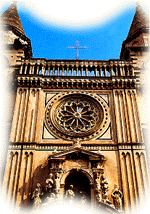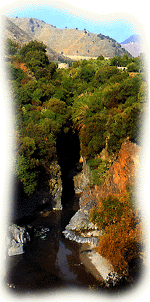 |


|
|
THE IONIAN COAST AND THE CYCLOPS RIVIERA |
|
| Partly dominated by the Timpa ridge at Acireale, the city of a hundred churches, the coast winds through Cannizzaro, Aci Castello, Aci Trezza and Capo Mulini. Passing prestigious hotels well inserted into the natural environment, at the port of Aci Castello the route leads onto a high basaltic promontory dominated by the dark, majestic lava walls of an ancient castle, theatre of many a legend: from the love between the nymph Galatea and the shepherd boy Aci to the rage of Polifemo. Used by the Byzantines, Saracens and Normans, the castle was donated by the latter to the Bishop of Catania and it was here that the relics of St.Agatha were brought from Constantinople to be buried in 1126. Aci Trezza, perhaps the best known of these towns on the Ionian Sea, owes much of its fame to Giovanni Verga who set his powerful novel "I Malavoglia" here and to Luchino Visconti who, many years later, made the famous film "La terra trema" in this location. The Cyclops Islands are situated in this sea and on Lachea, the largest of the islands, there is an important marine biology centre. Acireale, the ancient city of Aquilia Nova, is situated between the sea and the heights of the Timpa. The town is famous for its baroque architecture, seen in the harmony of a great constellation of churches and "palazzi" of striking beauty. From the Cathedral, the work of Placido Blandamonte, with its magnificent portal, to the church of St. Sebastian whose external balustrade, complex and composite like a stone lacework, is topped by 10 fine statues by G.B. Marino, to the marvellous public and private buildings, the architecture celebrates the garish, immodest triumph of a style which was not merely an appearance but also the cultural substance of that "Siglo de Oro" on which much of Sicilian culture was to flourish. This lively culture can be appreciated in the Zelantina library and gallery at Acirelae: founded in 1716 by the Zelanti family, its precious manuscripts and 50,000 volumes attract students from all over the world. The city's artistic patrimony is noteworthy with works by great masters like Paola Vasta, Giacinto Platania and Giuseppe Sciuti in the various churches and "palazzi". We should also mention the fine quality handicrafts of past and present, ranging from the work of gold and silversmiths, to that of stucco decorators of the Etna baroque style in which black lava stone is combined with white marble and grey clear stone in a truly unique symphony of chromatic and volumetric effects. In this splendid town where the sacred and profane mix in harmony, one cannot fail to mention the Carnival celebrations - which are unique in Sicily - as well as the learned tradition of the puppet theatre and the fine ancient spas. Giarre, Riposto and Calatabiano conclude our itinerary along the coast: well known for the natural beauty of the locations, these towns are worth mentioning for other aspects. Giarre, designed on the basis of an 18th century urban plan, is the home of flourishing handicrafts, particularly wrought iron and terracotta. Riposto, situated on the edge of an extremely beautiful beach, is the site of a prestigious nautical institute which produced many a captain in skirts, well before the age of militant feminism. Calatabiano, situated between two castles bordering the town from the summit of a hill down to the beautiful St. Mark's beach, is the gateway to the Alcantare gorges. Here the wate has dug its course along the millenary bed of a stream of lava and precipitates down a wild, frightening gorge formed of stratified basaltic rocks. For those who wish to experience the thrill of a walk in this watery hell, it is enough to equip onself with a pair of fisherman's boots - which can be hired on the spot - and prudently proceed towards this fantastic adventure.
|
||



